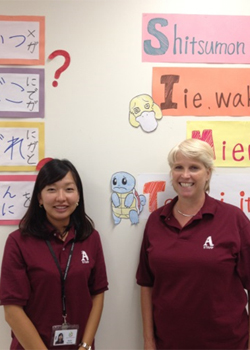

 2014 J-LEAP Report
2014 J-LEAP Report
Appoquinimink High School
Middletown, DE
Hello. My name is Kaori Nishida and I am currently working as a teaching assistant at Appoquinimink High School in Middletown, Delaware.
What is a Delaware? When I first time I heard the name Delaware, the first thought that came to mind was “Is it a Grape…?” I didn’t know anything about Delaware except Grape. But I like Grape, so I looked forward to going to Delaware. I think most Japanese don’t know about Delaware, which was also the case with me.
Delaware is famous for being the first state and also the second smallest state in the U.S. Unfortunately, there are no grape fields around my school, but there are many corn fields and horses nearby. On my way to school, I can see horses every day. I miss Grapes, but there is so much beautiful nature here and I like here very much.
In Japan, we study five subjects along with music, art, and calligraphy in high school. But at Appoquinimink High School, students can choose from many subjects, for example, they have graphic art, animal science, ROTC, photography, etc. I think it’s good for students to have many choices for their future. There is also a bank at the school for students who want to work in the banking industry to practice. As for language education, students can choose from the following five languages: French, Spanish, American Sign Language, Chinese and Japanese.
It hasn’t even been one month since school started, but I want to introduce what I am doing in here.
We have three levels of Japanese (Japanese 1, 3 and 5) this semester. In Japanese 1, there are 20 students who studied Japanese in middle school or are studying Japanese for the first time. In Japanese 3, there are 20 students who have completed Japanese 1 and 2. In Japanese 5, there are seven students who have completed Japanese 1, 2 ,3 and 4. In Delaware, there aren’t many opportunities to meet native Japanese speakers, so Mrs. Bradshaw, who is my supervisor, and I provide a lot of class time for listening and speaking practice in Japanese. It’s difficult for Japanese 1 students, but for Japanese 5 students, they spoke in English during the first week, but now they try to speak in Japanese every day.
They also learn how to write Hiragana, Katakana and Kanji. When we teach Kanji, I demonstrate how to write Kanji and then we check to make sure that they are writing it correctly. This way, they study not only speaking but also writing. Hiragana is especially important because if they learn it wrong it becomes a bad habit, so we pay attention to this very carefully. Introducing Kanji is part of my responsibility and I consult with Mrs. Bradshaw to come up with ideas to get students interesting in learning Kanji. Now, I am trying to come up with new activities to not only write Kanji, but also make the experience fun and interesting.
In Japan, we learn grammar through repetition, but in the U.S. it’s more important for teachers to make class interesting and interactive for the students. Every day in class, Mrs. Bradshaw has many ideas for lessons that motivate students to develop a genuine interest in Japanese. It’s not just about teaching the language, but engaging the students through their body and mind.
My wish is for my students to like Japan more and want to study and speak Japanese more. I want them to feel the joy that comes with knowing that you can communicate with someone from a different country.
I think about what can I do for my students all the time, but I have yet to find an answer. It’s difficult to find a good answer; however, I want to try many things to motivate the students to speak and practice Japanese more. That is my challenge while I am here. I also want to bring good teaching ideas back to Japan.
Finally, I really appreciate all the people who have made this opportunity for me possible and I would like to say thank you to my supervisor Mrs. Bradshaw, my colleagues at school and my lovely host family Bob and Gail. If it were not for them, my life in the U.S. would have been much more difficult. They support me every day and I really appreciate that. I have realized again the importance of personal relationships and I will do my best during my time here.